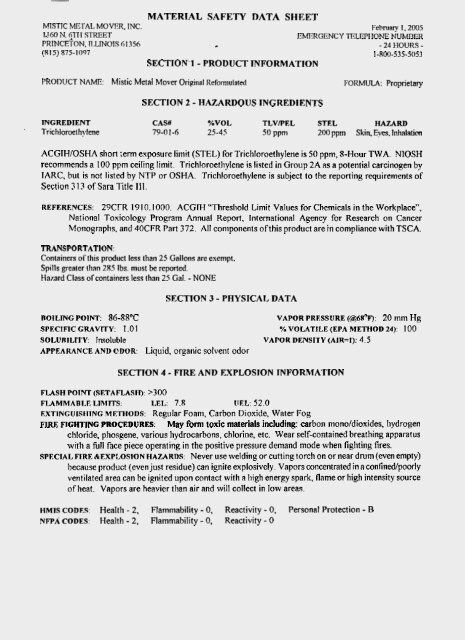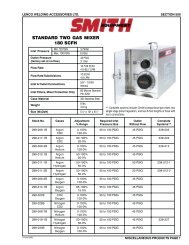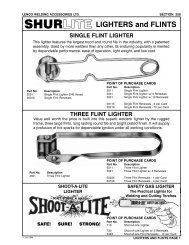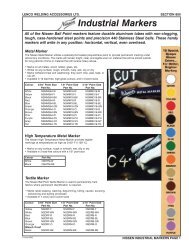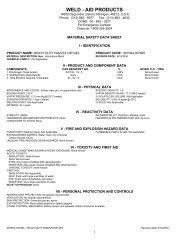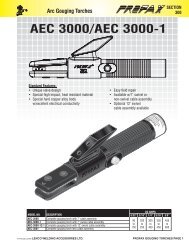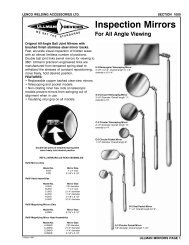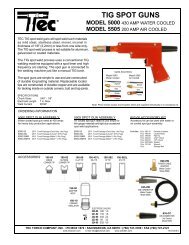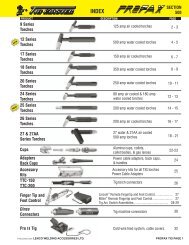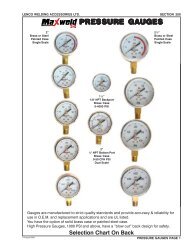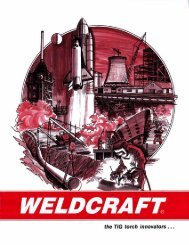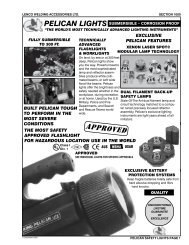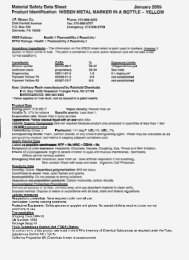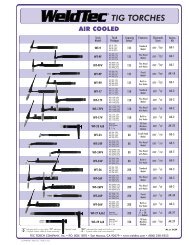Mistic Metal Mover Original
Mistic Metal Mover Original
Mistic Metal Mover Original
You also want an ePaper? Increase the reach of your titles
YUMPU automatically turns print PDFs into web optimized ePapers that Google loves.
MATERIAL SAFETY DATA SHEET<br />
MISTJC METAL MOVER. INC. Februay 1,2005<br />
V GO N. hl'f 1 STREET<br />
I3MRGGNCY TELEPI IONE NUMBER<br />
PRINCE'PON, ~,CTNOJS 6 t 356 - - 24 HOURS -<br />
(8 1 5) 875-1097 1 -800-535-5053<br />
SECTION-1 - PRODUCT INFORMATION<br />
PRODUCT N M : hlislic <strong>Metal</strong> <strong>Mover</strong> Originnt Reforniulatcd<br />
FORMULA: Proprietary<br />
SECTION 2 - HAZARDOUS INGREDIENTS<br />
+<br />
INGREDIENT CAS# %VOL TLVTPEL STEL HA=-<br />
Trichlotmil~~lcne 79-01-6 25-45 50 PPm 200 ppm Skin, Eys, Inhalation<br />
ACGVH/OSHA short ;em exposure limit (STEL) for Trid~loroethyIene is 50 ppm, 8-Hour TWA. NOSH<br />
recommends a I00 ppm ceiling Iimi t. Tsichloroethylene is listed in Group 2A as a potential carcinogen by<br />
IARC, but is not listed by NTP or OSHA. TrichloroethyZene is subject to the reporting requirements of<br />
Section 3 13 of Sara Title 1 il.<br />
REFERENCES: 29CTR 19 10.1000. ACGW "Thresllold Limit Values for Chemicals in the Workplace",<br />
National Toxicology Program Annual Repod, International Agency for Research on Cancer<br />
Morrograptts. and 40CFR I'nrt 372. At1 conlponents ofthis prodrtct are in compliance with TSCA.<br />
TRhNSPORTATION:<br />
Containers of this product less than 25 Gallons are exempt.<br />
Spills greater 1han 285 Ibs. must k reported.<br />
Hazard Class orconzainers less than 25 Gal. - NONE<br />
SECTION 3 - PHYSICAIA DATA<br />
ROIL~G POINT: 8G-88'C<br />
VAPOR PRESSURE (@6RRF): 20 mm Hg<br />
SPECIFIC GRAVITY: 1.01 % VOLATILE (EPA METHOD 24): 100<br />
SOLURILITV: Insoluble VAPOR DENSITY (AlR=I): 4.5<br />
APPEARANCE AND cDoR. Liquid, orgarlic solvent odor<br />
SECTION I - FlRE AND EXPLOSION JNlj'ORMATlON<br />
FLASH POINT (SETAFLASI I)- >300<br />
FLAMMARLE LIMITS: LEL: 7.8 IIEL: 52.0<br />
EXTINGUISEIINC METHODS: Regllfnr Foam, Carbon Ui oxide, Water Fog<br />
FIRE SIGHTING PROCEDURES. May form toxic materials including: carbon monoldioxides, llydrogen<br />
chloride, phosgene, various hydrocarbons, chlorine, efc. Wear self-contained breathing apparatus<br />
with a h'FI face piece operating in the positive pressure demand mode when figlit ing fires.<br />
SPECIdL FlRE &EXPLOSION HAZ~RDS: Never use welding or cutting torch on or near drum (even empty)<br />
because product (even just residue] can ignite explosively. Vapors concentrated in a confindpoorly<br />
ventilated area can be ignited tlpon contact with zt high energy spark, flame or high intensity source<br />
of I~eat, Vapors are heavier than air and will collect in low areas.<br />
HMIS CODES Health - 2, Flarnniability - 0, Reactivity - 0, Personal Protection - B<br />
NFPd CODES Health - 2, Flarnmabili ty - 0, Reactivity - 0
SECTION 5 - HEALTH HAZARD DATA<br />
Ems. Liq~lid.rnay cause pain. May cause slight transi~n! (temporary) irritation with slight trinsient<br />
corneal in-iury. Vapors may irritate eyes causing redness, tearing, or blurred vision. Contact lenses<br />
must not be worn when possibility exists for eve contact due to spraying liquid or airborne particles.<br />
SKm: Prolonged or repeated contact can cause moderate irritation, defatting and dermatitis.<br />
RREA~ING: Excessive inhalation of vapors can cause nasal and respiratory irrit ntion, central nervous<br />
system effects it~cluding dizziness, weakness, fatigue, nausea, headache and possible<br />
unconsciousness.<br />
CONCEIYTRATIQNS of Trichloroethylene in the 500 to 1000 pprn range may produce minimal anesthetic or<br />
narcotic effects. Progressively higher concentrations over 1000 pprn can cause dizziness or<br />
dn~nkenxless. Concentrations as tow as 10,000 can cause unconsciousness and even death. These<br />
Iligla levels may also cause blood pressure depression, cardiac sensitization and ventricular<br />
arrhythmias. In confined or poorly ventilated areas, vapors which readily accumulate can cause<br />
unconsciousness and death. LC50 irlflalation (rats) is 8.000 ppd4 hour.<br />
STUDIES IN LAB animals have shown Trichloroethylene in aerosol form to be mare acutely toxic than<br />
Tsicllloroet lly Iene vapor.<br />
SWALLOIVING. Single dose oral toxicity of Tricllloroethylene is low. The LD50 ingestion (rats) is4900 -<br />
7001) MG/KC;. The 96 hour LC50 for Mysid Shrimp is 14 MGL - slightly toxic. Aspiration of<br />
material into the lungs can cause chemical pneutnonitis which can be fatal. If aspirated, may be<br />
rapidly nbsorhed through the lungs and result in injury to other body systems.<br />
FIRST AID/F,MERGF,NCY PROCEDURES<br />
UYHALATION: Remove to Fresh air, Ifbreathing is diffia~lt, administer oxygen, If breathing has stopped,<br />
give artificial respiration. Keep person warm, quiet and get medical attention. Do not give<br />
stimulants. Epinephrine or ephedrine may adversely afTect the heart with Fatal results.<br />
SKIFF CONTACT: Wash thoroughly wit11 soap and water. Remove contaminated clothing. Launder<br />
contaminated cIotIling before re-use.<br />
EYES: Flush with copious amounts of water. Get medical attention.<br />
~GESTION: Do not induce vomiting. Immediately drink two glasses of water. Get medical attention.<br />
Never give anything by mouth to an unconscious person. Aspiration of material into the lungs due<br />
to vomiting can cause chemical pneurnonitis which can be fatal.<br />
NOTE TO PHYSICIAN: Because of rapid absorption may occur through the lungs if aspirated and cause<br />
systemic erects, the decision to induce vomiting or not should be made by attending pl~ysician. If<br />
lavage is performed, suggest endotrachea! andlor esophageal control. Danger from lung aspiration<br />
must be weighed against toxicity of TrichloroerP~ylene when considering emptying the stomach.<br />
Exposure may increase "Myocardial Irritability". Do not administer sympathomirnetic drugs unless<br />
absolutely necessary. No specific antidote.<br />
PRIMARY ENTRY ROUTE(S): Inlialation, skin absorption, skin contact.<br />
CHRONlC HEALTH EFFECTS: Overexposure to trichloroethylene has been found to cause the following<br />
effects in laboratory animals: kidney and lung damage.<br />
OVERRXPOSURE to Trichloroethylene has been suggested as a cause of the following effects in humans:<br />
cardiac abnormality, liver abnornialities, kidney datnage. Wile there are studies in which tumors<br />
were iriduced in mice, there is no documented evidence that exposure to trichloroethylene produces<br />
cancer in humans.
SECTION 6 - HEACTIVITY DATA<br />
II"AmRnQUS POLYMERl7ATION: Canndt Occur<br />
STABILITY Liquid oxygen or other strong oxidants may form explosive mixlures with Trichloroethylene.<br />
JNCOMPATIRILITY: Avoid contact with: water, reactive metals such as aluininum find magnesium,<br />
open flame, weldi~rg arcs, resistance heaters, etc. which can result in thermal decornposit ion -<br />
releasing hydrogen chloride and small ~ O U I I of ~ S phosgene and chlorine, strong oxidizing agents,<br />
and strong alkalies.<br />
SECTION 7 - SPELL OR LEAK PROCEDURE<br />
PROCEDURES FOR SPILULEAK: Trichloroethylene vapors are heavier than air and will collect in low<br />
areas. Eliminate all ignition sources (flares, flames including, pilot lights, electrical sparks, etc.)<br />
SMALL SPILL: Ab~orb liquid on paper, vermiculite, floor absorbent, or other absorbent material and<br />
transfer to safz evaporation area.<br />
URGE SPILL: Percons not wearing protective equiprnerlt should be excluded from area of spill until<br />
cleanup has bzen completed. Stop spill at source. Dike area of spill to prevent spreading. Pump<br />
liquid to salvage tank. Remaining liquid may be taken up on sand, clay, earth, floor absorbent, or<br />
other absorbent material and shoveled into containers.<br />
PREVENT RUN-OFF TO: Sewers, streams or otllet bodies of water. Notify proper authorities, as required,<br />
that a spill llns occurred.<br />
WASTE MANAGEMENT: Dispose of in accordance with all local, state, and federal segulat ions.<br />
SECTION 8 - PROTECTIVE EQUIPMENT TO BE USED<br />
RESPIRATORY PROTECTION: If workplace exposure limit(s) of product is exceeded, a NlOSWMSHA<br />
approved air supplied respirator is advised in the absence of proper environmental control. OSHA<br />
regulations also permit orher NIOSH/TWiHA respirators (negative pressure type) under specified<br />
conditions. EngEt~eering or administrative controls silould be itnplemented to reduce exposure.<br />
VENTILATION: Provide sufficient mechanical (general and/or local exhaust) ventilation to maintain<br />
mir~irnum exposure.<br />
EYE PROTECTION:<br />
eye or face ccntact can occur.<br />
G WVES:<br />
Chernical splasl~ proof goggles and full face shield are advised for operations where<br />
Wear impervious gloves such as polyvinyl alcohol, vit ron(r), silver shield(r).<br />
To prevent repea red or prolonged skin contact, wear impervious<br />
clothing and kmis. Consult your supervisor.<br />
OTHER PROTEflIVE EQUIPMENT.<br />
SECTTON 9 - SPECIAL PRECAUTIONS OR OTIIER COMMENTS<br />
ALUMINUM equipment sl~ould not be used for storage andlor transfer, e.g. pumps, mixers, fittings, storage<br />
tanks, etc. Contact with alumin~in~ parts in a pressurized fluid system may cause a violent reaction.<br />
USE ONLY W m adequate ventilation. Ventilation must be suficient to limit employee exposure to<br />
trichloroethylene below permissibIe limits. Observance of lower limits is advisable.<br />
TO AVOID skin contact artd ingestion, wash hands and face well before eating or smoking. Do nor permit<br />
food in work area. Avoid breatl~ing mists if generated. Store at room temperature. P-estal<br />
container when not in use,<br />
CoNTAlnERs of this n~ateriall may be hazardous when emptied, since emptied containers retain product<br />
residues (vapor and/or liquid).<br />
SAM TWLE 111 - A) 3 1 I/> 12 Categories - Acute and Chronic, B) Listed in section 3 13 under<br />
Trichloroethylene. C) Not listed as an "Extremely Hazardous Substamce" in Section 302.
CERCLA - Listed in Tijble 302.4 of 40 CFR PART 302 as a hazardous substat~ce wit11 a reportable quantity<br />
of 100 pouncts. Re.leases 10 air, land or water which exceed the reportable quantity must he<br />
reported to tfw national response center, (800) 424-8832.<br />
A<br />
RCRA - Waste tricl~loroe!:~ylene and contaminated soilslnlri-erials from spill cleanup and U228 Hazardous<br />
waste as per 40 CFR 261.33 and must be disposed of accordingly under RCRA. See 40 CFR<br />
26 1.33 H ar~ct 26 E .7(B)(3) for cleaning requirement: i'or empty containers.<br />
CALlFORNL.4 PROP031TION 65 - Trichloroetl~ylene is a c'tlemical known to the State of California to cause<br />
cancer.<br />
NEW JERSEY RIGHT-'rO-KNOW - Also contains Etllylene Oxide (CASfl106-88-7)<br />
CANADIAN WIlMIS - A) Sensitization to product: None Known, l3) Reproductive Toxicity: None Known,<br />
C) Odor Tlircshold: Not Known, B) Product Use: Lrrbricant/Degre;lsitlg, 6) Requires Poison<br />
Symbol (Class D. I$.<br />
As of the dde of preprrmtion ofthis doctmnrmf, the fnrqloinr information k belim4edto he acctrrde and isp#l1irled in good<br />
fdrh to compl~ rlilh ~~rplicmhle federn1 and sfde In~r*(s). Ifoal~r*er, no wunrrnn@ or r~pre.renfntinn vtlhlt rexpecl lo strch<br />
iqfnmnrion is irrr~rtded or givrn.


